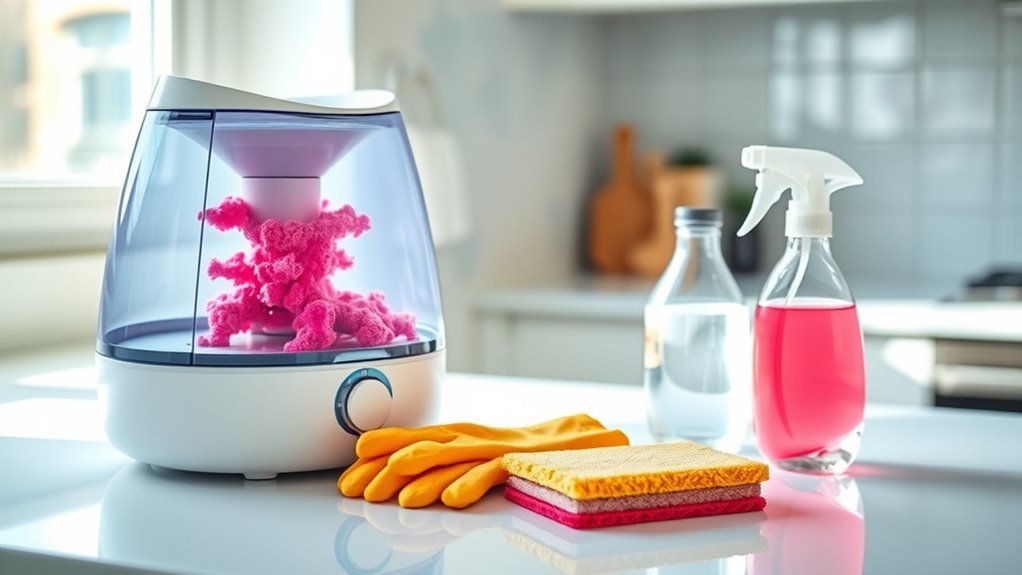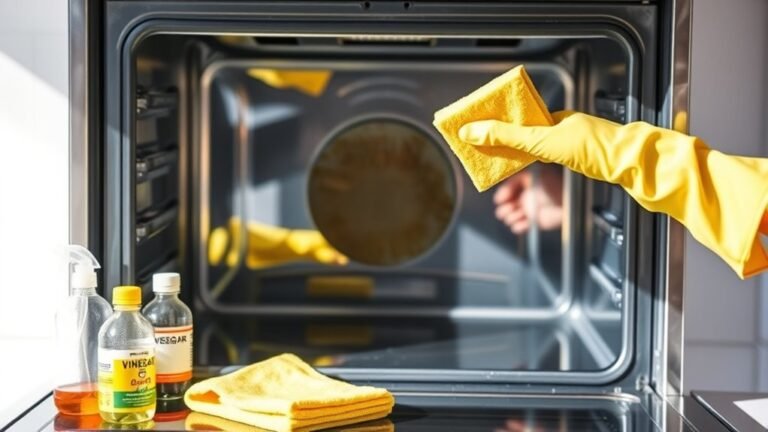How to Clean Pink Mold in Humidifier
To clean pink mold in your humidifier, unplug it and disassemble according to the manufacturer’s instructions. Soak affected parts in a mixture of equal parts water and white vinegar for 30 minutes. Use a soft brush to scrub the areas, then rinse thoroughly with clean water. Remember to wear gloves and a mask for safety, and guarantee proper ventilation. Establish a regular cleaning routine to prevent mold from returning; further insights on maintenance are ahead.
##

If you’re looking to maintain a clean and efficient humidifier while preventing the growth of pink mold, you’ve come to the right place. This article will provide you with essential tips and practices to ensure your humidifier operates effectively and keeps the air you breathe healthy. From daily maintenance routines to the best cleaning solutions, you’ll discover straightforward steps to minimize mold growth and enhance the performance of your humidifier. By following these guidelines, you can create a healthier living environment for yourself and your loved ones.
Preparation For Cleaning
Before you start the cleaning process, it’s important to gather all the necessary supplies and prepare your workspace. Create a designated area that’s well-ventilated and away from children and pets. This not only guarantees your safety but also aids in effective mold prevention. Check your cleaning schedule to determine how often you’ll need to clean your humidifier; regular maintenance can greatly reduce mold buildup. Have a checklist of items ready, including gloves, a mask, and towels. Make certain to have cleaning agents that are suitable for mold removal. By organizing your supplies and space beforehand, you’ll streamline the cleaning process and ensure you can tackle the pink mold efficiently, ultimately fostering a healthier environment.
Tools and Chemical Required

To effectively tackle pink mold in your humidifier, you’ll need a specific set of tools and cleaning agents tailored for mold removal. Here’s a concise list to guide you:
| Tools | Cleaning Agents |
|---|---|
| Soft-bristle brush | White vinegar |
| Microfiber cloth | Hydrogen peroxide |
| Bucket | Baking soda |
| Gloves | Commercial mold cleaner |
Using these cleaning agents will not only help in mold removal but also assist in mold prevention for future use. Make sure you wear gloves while handling chemicals and follow the manufacturer’s guidelines for safety. With the right tools and agents, you can maintain a mold-free humidifier, enhancing your indoor air quality effectively. Choosing natural formulas helps minimize water pollution and supports a healthier environment while cleaning.
How to Clean:

Step 1: Unplug the Humidifier
– Begin by ensuring that your humidifier is completely unplugged from the power source. This is crucial for your safety while cleaning.
Step 2: Disassemble the Humidifier
– Carefully disassemble your humidifier according to the manufacturer’s instructions. This typically involves removing the water tank, filter, and any other detachable parts. Make sure to keep track of all components for easy reassembly.
Step 3: Prepare the Cleaning Solution
– In a clean container, mix equal parts of water and white vinegar. This solution is effective in breaking down and removing pink mold.
Step 4: Soak Affected Parts
– Submerge the parts that have visible mold in the vinegar-water solution. Let them soak for at least 30 minutes to help loosen the mold.
Step 5: Scrub the Affected Areas
– After soaking, use a soft brush (like a toothbrush) to scrub away the mold from the surfaces of the humidifier parts. Pay special attention to crevices and hard-to-reach areas where mold may linger.
Step 6: Rinse Thoroughly
– Once you have scrubbed all affected areas, rinse each part thoroughly with clean water. This step is important to ensure that any vinegar residue is completely removed.
Step 7: Dry All Components
– After rinsing, dry all components completely with a clean, dry cloth or let them air dry. This prevents moisture from remaining, which could lead to future mold growth.
Step 8: Reassemble the Humidifier
– Once all parts are completely dry, carefully reassemble your humidifier, ensuring that each component is fitted correctly according to the manufacturer’s instructions.
Step 9: Prevent Future Growth
– To minimize the risk of pink mold returning, consider using distilled water instead of tap water in your humidifier. Additionally, make it a habit to clean your humidifier weekly to maintain a healthy environment.
Step 10: Regular Maintenance
– Establish a routine for checking and maintaining your humidifier. Regular maintenance is essential for preventing the return of pink mold and ensuring optimal performance. Also, setting a regular cleaning schedule helps avoid unexpected breakdowns and keeps your appliance functioning properly.
Safety Consideration

While maintaining your humidifier is essential for preventing mold growth, it’s equally important to prioritize safety during the cleaning process. When dealing with pink mold, you must be cautious of mold exposure, as it can pose significant health risks. Always wear gloves and a mask while cleaning to protect yourself from inhaling spores or coming into contact with mold. Make certain your working area is well-ventilated to reduce the concentration of any potentially harmful particles. If you notice any allergic reactions or respiratory issues while cleaning, stop immediately and consult a healthcare professional. By taking these precautions, you can maintain a safe environment while effectively addressing mold issues in your humidifier, ensuring both your health and the device’s longevity.
Tips to keep clean for long time
Maintaining a clean humidifier is essential for preventing the recurrence of pink mold, especially since even a small amount of residue can lead to future growth. To guarantee long-lasting cleanliness, establish a consistent maintenance routine. Regularly empty the tank, rinse it with clean water, and dry all components to minimize moisture retention. Incorporate preventive measures, such as using distilled water, which contains fewer minerals than tap water, reducing the buildup of deposits. Consider adding a few drops of white vinegar to the water for additional antibacterial properties. Finally, inspect and clean the humidifier weekly, focusing on any hard-to-reach areas. Using eco-friendly cleaning products during this process ensures safety and effectiveness. By following these steps, you can enjoy the benefits of your humidifier without the worry of pink mold reappearing.
Frequently Asked Questions
What Causes Pink Mold to Grow in Humidifiers?
Pink mold grows in humidifiers primarily due to poor humidifier maintenance and high humidity levels. When water sits stagnant, it creates an ideal environment for bacteria and mold to thrive. To prevent this, make sure you’re regularly cleaning your humidifier and replacing the water frequently. Keeping your humidifier in a well-ventilated area can also help reduce humidity. By practicing these mold prevention methods, you’ll enjoy cleaner air and a healthier home environment.
Can I Use Vinegar Instead of Bleach for Cleaning?
Yes, you can use vinegar instead of bleach for cleaning. Vinegar’s effectiveness as a natural disinfectant makes it a strong cleaning alternative. It can help eliminate mold and bacteria without the harsh chemicals found in bleach. However, while vinegar’s acidity can tackle some mold, it might not be as potent as bleach for severe cases. If you’re looking for a more eco-friendly solution, vinegar is a great choice to maintain your humidifier’s cleanliness.
How Often Should I Clean My Humidifier?
You should clean your humidifier at least once a week for ideal maintenance. Ironically, neglecting this task might seem like a time-saver, but it can lead to a build-up of harmful mold and bacteria, undermining your health. Regular cleaning not only guarantees fresh air but also extends the life of your device. So, embrace the freedom of clean air by committing to a consistent cleaning frequency—it’s a small effort for big rewards!
Is Pink Mold Harmful to My Health?
Yes, pink mold can be harmful to your health. It’s often linked to respiratory issues, allergies, and other infections, especially if you’re sensitive or have a weakened immune system. When using a humidifier, ensuring its safety is vital; inhaling spores can exacerbate existing conditions. Regular cleaning and maintenance are essential to minimize risks. If you notice pink mold, it’s important to address it promptly to safeguard your well-being and maintain a healthy environment.
What Should I Do if Mold Returns After Cleaning?
If mold returns after cleaning, you should implement preventive measures immediately. Start by ensuring your humidifier’s water is changed daily, as stagnant water promotes mold growth. Consider using distilled water, which has fewer impurities. Regularly clean the humidifier with a vinegar solution to inhibit mold prevention. Finally, keep the room well-ventilated and maintain humidity levels below 50%, reducing the chances of mold reemerging. Consistent maintenance is key to mold-free air.






